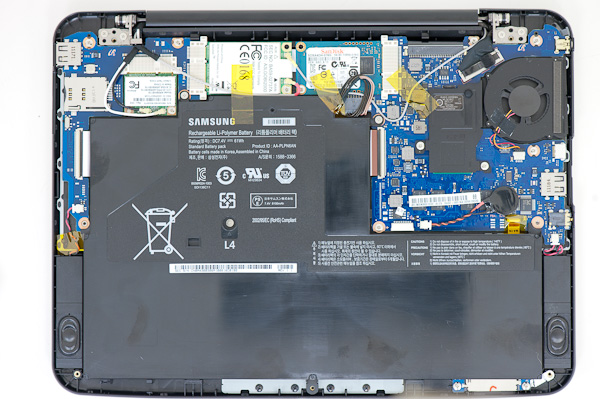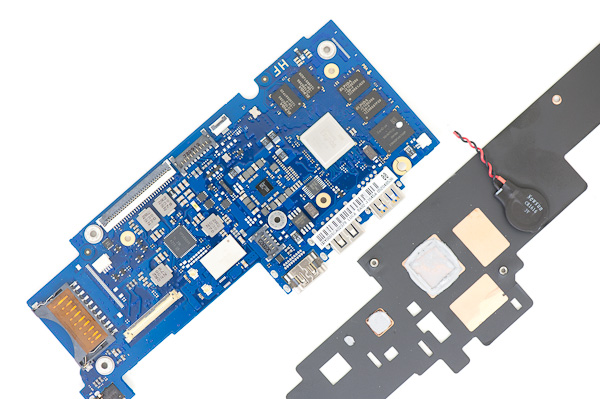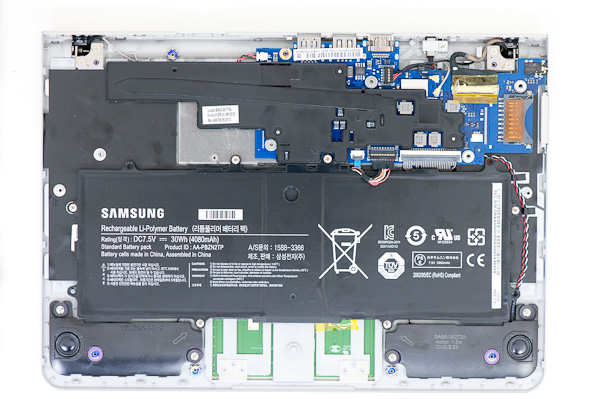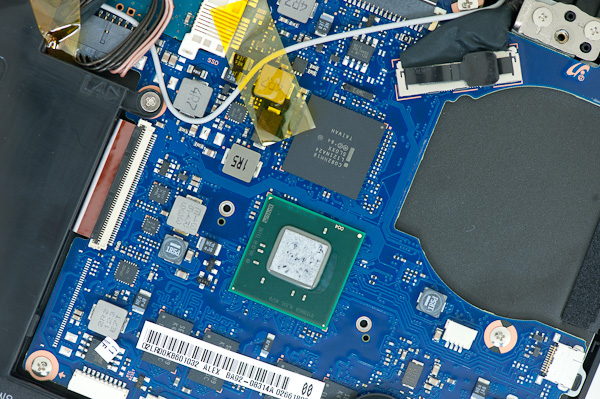Samsung Chromebook (XE303) Review: Testing ARM's Cortex A15
by Anand Lal Shimpi on October 31, 2012 9:00 AM ESTInside the new Chromebook
Similar to its predecessors, getting access to the internals of the new Chromebook doesn't require anything more than a tiny Phillips head screwdriver. There are four exposed screws and four more under the feet beneath the chassis. Remove all eight screws and you can pry off the bottom cover. The cover snaps into place so be careful if/when you remove it.
Inside the new Chromebook is a far more simplified setup. It honestly looks more like a modern day tablet under the hood. I never got the Celeron based Chromebook 550, but I do have the 500 which featured a dual-core Atom N570 processor. Here's a shot of that model for comparison:

The old Atom N570 based Chromebook
Right off the bat you'll notice a significant reduction in battery capacity. That old N570 based Chromebook had a mammoth 61Wh battery compared to the more tablet-sized 30Wh battery in the new model.
The old motherboard was also far less integrated. Discrete cards were used to provide cellular and WiFi connectivity, whereas the new board integrates WiFi (Marvell?) directly onto the motherboard.
The cost reduction extends to the SoC side as well. Intel charges $86 for an Atom N570, while the going rate for high-end ARM based SoCs is in the $20 - $30 range (and this is why ARM is the new AMD when it comes to keeping Intel pricing in check). I also suspect that this first run of Samsung Exynos 5 Dual chips are a bit leakier and perhaps even lower yielding than what we'll eventually see down the road. Samsung could be motivated to move these parts at a better cost structure as they work out kinks in manufacturing.
Note that the previous Atom solution required two chips: the N570 and its NM10 Express PCH. The N570 had a 2.1W TDP and was used for all IO, while the N570 and its two Atom cores needed about 8.5W. The combination was fine for a notebook but when Haswell can deliver much better performance within the same TDP, it's clear the old 45nm CPU + chipset were getting long in the tooth.

The far simplified, single-chip Samsung Exynos 5 Dual solution
Despite the absence of any significant heatsink, to remove 10.6W of heat you do need forced air convection hence the inclusion of a fan in the old Chromebook 500. The thermal requirements of the Exynos 5 Dual are significantly lower. The SoC benefits from Samsung's 32nm HK+MG LP process and is highly integrated, meaning there's only a single chip. Although there's a big heatspreader plate complete with heatpipe that runs over the Exynos 5, there's no fan needed. Removing the fan lowers build cost, reduces internal complexity, and helped Samsung shrink the chassis size.
There are a total of 8 x 256MB DDR3L devices (2GB total) that surround the Exynos 5 Dual SoC (4 on each side of the PCB). Each device is 8-bits wide, all connecting up to the 64-bit wide DDR3L memory controller. The DRAM is clocked at a 1600MHz data rate, resulting in 12.8GB/s of memory bandwidth to the chip. The Exynos 5 Dual integrates two ARM Cortex A15 CPU cores as well as an ARM Mali-T604 GPU.

The other big change on the motherboard is the move from a SanDisk discrete controller + NAND device to an integrated iNAND solution for storage. Capacity remains unchanged at 16GB, but the integrated eMMC controller does offer board (and perhaps cost) savings.
Moving to a lower power SoC not only gave Samsung some flexiblity in cooling, it also allowed it to run the platform with a much smaller battery. While the old Chromebook 500 used a massive 61Wh battery, the new model only needs a 30Wh unit. Battery life has gone down (Exynos 5 Dual isn't 2x more power efficient than the 45nm Atom N570) but so has weight as well. I believe the Chromebook 550 ditched the giant battery and moved to a ~40Wh unit, so the difference isn't as drastic there.




















149 Comments
View All Comments
iwod - Thursday, November 1, 2012 - link
Both Atom and Sandy /Ivy Bridge uses 4 thread compared to 2 threads the Cortex A15 uses. A better comparison would be a Quad Core A15. Which free the Core from doing other work in a Single Threaded Benchmarks and better illustrate mutithreaded performance.The A50 will offer 20 - 30% performance increase compared to A15 at 32 bit and further improvement at 64bit mode. This, with higher frequency and Quad Core or Hex Core will surely bridge the gap between everyday Laptop and a Chromebook.
Krysto - Thursday, November 1, 2012 - link
It doesn't matter. HT is pretty gimmicky anyway. You can maybe 10% improvement in performance.Don't forget A57 will not just have better IPC than A15, but will also go to higher clock speeds - up to 3 Ghz, actually. A quad core A57 chip at 3 Ghz will be more than enough performance for most people, while having very good battery life.
nishantmohan - Thursday, November 1, 2012 - link
"Plugging the Chromebook into a relatively modern (~2 year old) Samsung LED backlit LCD HTDV caused the Chromebook to reboot itself."i dont know why but I burst into laughter when i saw this....
legoman666 - Thursday, November 1, 2012 - link
Any word on the ship date for the 3g version? I preordered one on Amazon on the 19th, no word on ship date and I can't find one mentioned anywhere.TrackSmart - Thursday, November 1, 2012 - link
I opened this page and got taken here: http://testables.net/d/juicyru.comI'm guessing this is not what you guys agreed to regarding what advertisements on your site can do. Here's the brilliant message you get:
CONGRATULATIONS!
You've been selected from the [MY STATE] region to take part in our annual visitor survey.
This will only take 30 seconds of your time and will enhance user experience. Upon completion you will have the opportunity to get a iPad or iPad Mini, a $1000 Best Buy Card , or a $1,000 Visa Gift Card.
Mumrik - Friday, November 2, 2012 - link
"PC notebooks that still struggled with the same virus/malware issues they'd been facing for years"That comment had me confused. Is he talking about the crap companies put onto their non-business notebooks or did I miss some sort of virus/malware hell in 2010 that somehow later got solved?
yannigr - Friday, November 2, 2012 - link
This could be better, but it is okI have seen worst than this
What did you expect with so low price
This does not work but let's see something else that works
And here it is a USB 3.0 that works as a slow USB 2.0, and here it is a slot that it is not a slot but a hole
More or less this is what I was reading in this article. So you pay $249 and you buy a very light machine with overall poor quality and an OS that it is very limited in what you can do with it. And only 6 hour battery time?
Better buy a netbook, tablet or a second hand laptop for that price.
koss - Friday, November 2, 2012 - link
"Note that the previous Atom solution required two chips: the N570 and its NM10 Express PCH. The !!! -= N570 =- !!! had a 2.1W TDP and was used for all IO, while the N570 and its two Atom cores needed about 8.5W. "I guess that is the NM10 actually? Otherwise it makes no sense, to me at least.
I keep reading and loved the expression that "ARM is the new AMD", perhaps we should call them "ARMeD", since they are in the same boat now.
owned66 - Saturday, November 3, 2012 - link
put ubuntu on it = winruneks - Monday, November 5, 2012 - link
Anyone care to take a guess on how much this device would retail for if it included a battery with 50% or 100% more capacity? That would be a 45 or 60 Whr battery, respectively. I think it would fairly useful to be able to pull 9 hours from a single charge.